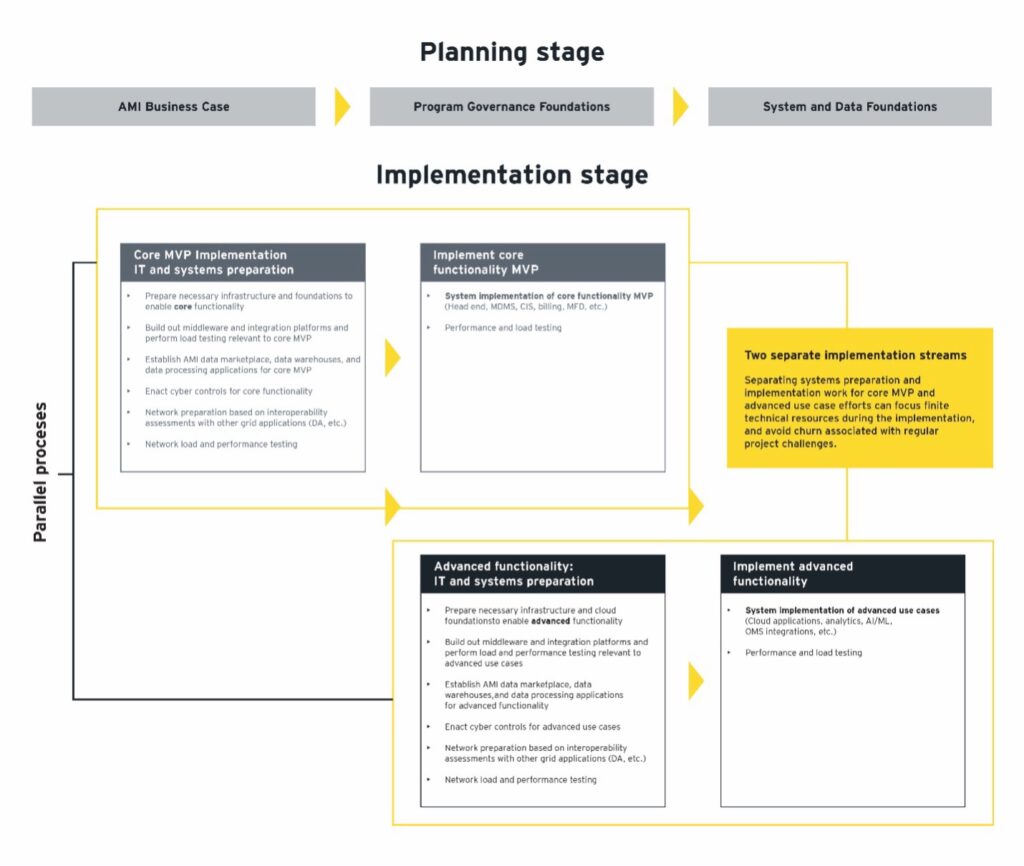Utilities seek to pursue critical advanced metering infrastructure (AMI) 2.0 outcomes, such as advanced analytics, demand response programs, outage management, distributed energy resource integration, and improved customer technology adoption by focusing on information technology strategy as an enabler to successful grid modernization.
Ryan Fehrenbacher and Michael Juchno, EY
As the electric distribution sector evolves, smart meters have become a focal point for utility technology modernization. Early smart meter implementations were largely successful in replacing legacy automated meter reading (AMR) systems, and collecting meter reads over the air. As advanced metering infrastructure (AMI) technology has developed, advancements in meter and information technology (IT) capabilities have led utilities to pursue more ambitious use cases in their AMI transformation programs. The pursuit of these advancements has introduced new challenges for utilities, most notably from an IT perspective, in standing up the technical foundations needed to enable new AMI technologies. While core AMI functionality continues to be implemented at scale across the U.S., more advanced AMI use cases have sometimes struggled to live up to their potential of improving operational efficiently and meeting customer expectations.
With advanced IT infrastructure and data analytics becoming paramount for the success of AMI 2.0, robust technical architecture and planning have become increasingly important in enabling the promise of AMI technology. AMI 2.0 programs need a new IT and customer-focused transformation paradigm, from business case ideation to implementation. This article will discuss the foundational components needed to enable AMI 2.0. These components aim to establish a technical foundation that supports advanced AMI use cases and leads to increased customer satisfaction, interoperability among utility business capabilities, and operational efficiency.
Unlocking the Potential of AMI 2.0: Challenges and Opportunities
The advent of AMI 2.0 technology has enabled a new era for utilities, promising improved operational efficiency, enhanced customer interaction with the grid and modernized power grid applications. However, in some cases across the U.S., early and recent AMI implementations have fallen short of these ambitious goals.
The initial foray into smart metering was marked by a focus on transitioning from AMR to remote reads over the air. While this functionality has become commonplace across U.S. utilities, the more ambitious goals of advanced analytics and customer data access have been challenging to fulfill and require a renewed focus to enable the promise of AMI 2.0 technology. The latest EY Future of Energy survey reveals that the most significant trends anticipated to have a positive impact on the industry are the adoption of new technologies, especially operational technology, coupled with the evolution of the workforce to effectively support these advancements.
The AMI 2.0 era brings new advanced capabilities for AMI, positioning it as a critical component for broader grid modernization efforts. Electric meters have evolved into sophisticated devices that enable utilities to modernize operations and foster innovation. The rise of distributed energy resources (DERs), distributed intelligence “at the edge,” and increased customer demands for energy information have accelerated the need for utilities to evolve and enable these use cases. As many utilities now seek funding for AMI 2.0, they face growing demands from regulators and ratepayers to justify the substantial costs involved in pursuing these upgrades.
To capitalize on the promises of AMI 2.0 technology and successfully execute on digital transformation, utilities must lay a robust technical foundation to support advanced AMI use cases that will enhance customer satisfaction, increase interoperability among utility business capabilities, and improve operational efficiency.
Understanding the Past, Embracing the Future: Implementation Goals for AMI 2.0
To succeed in the AMI 2.0 era, utilities must acknowledge insights and lessons learned from previous AMI implementations. Let’s look at where early and recent AMI implementations fell short and how a new approach to AMI 2.0 programs can help address these challenges.
Previous Implementation Shortfalls. The first generation of smart meter implementations were largely focused on remote reads, remote disconnect, and integration with outage management. While many utilities also implemented customer-focused programs related to online billing presentment and usage alerts, challenges in understanding the true nature of customer desires, pain points, incentives, and barriers to adoption limited some AMI customer benefits.
Further, many early and recent adopters of AMI did not anticipate the additional investments in IT infrastructure needed to enable access to data across the enterprise and support AMI use cases. This lack of preparation meant that foundational IT work related to infrastructure, cloud, data warehousing, cybersecurity, network, middleware, development, and testing were often underfunded.
Additionally, the exponential increase in data volumes from AMI meters did not have corresponding data governance plans or appropriate changes to data architecture and master data management, which led to stress on core systems and IT infrastructure during and after implementation. Many utility business functions developed their own “shadow IT” data platforms replicating the same AMI data across the enterprise. This often resulted in project schedule delays, IT workarounds, and scope reduction.
For example, one North American utility spent more than $50 million on AMI hardware but only budgeted approximately $1 million for IT infrastructure upgrades. As a result, existing IT infrastructure struggled to process the data generated by the new advanced meters, leading to project scope reduction and costly IT workarounds.
Lack of performance-based contracts and vendor lock-in further hampered the flexibility and scalability of AMI systems. Contracts with vendors often lacked performance-based incentives and did not account for supply chain issues or limitations in solution capabilities.
Internal readiness was another significant challenge, as many utilities were not adequately prepared for the new business-as-usual (BAU) model required to manage and operate the advanced functionalities of AMI. Insufficient socialization of new BAU roles and responsibilities led to infighting and departmental “kingdom preservation” during implementation, as the necessary systems, personnel, and processes were not in place to handle AMI program changes.
Finally, a lack of AMI system interoperability led to restricted integration of utility capabilities, such as distribution automation, distributed intelligence, distributed energy resource management systems (DERMS), and home area networks (HANs). Reliance on single vendors for the entire network and hardware footprint further limited business flexibility, and opportunities for shared utility network infrastructure investments were missed. The inability to integrate various systems and technologies across open standards limited the overall effectiveness and benefits of the AMI rollout.
From a customer perspective, advocacy organizations have highlighted barriers in customer access to real-time energy usage data from advanced meters via Wi-Fi or Zigbee radio signals to the New York State Public Service Commission. While this technology is available on existing meters, the ability for customers to access this data via their HANs has faced challenges and delays in its implementation.
Objectives for Future Implementations. Moving forward, it is imperative that utilities garner lessons learned from past implementation challenges to fully harness the potential of AMI 2.0 technology. Today, the power grid is anything but predictable, with ongoing shifts driven by variability.
On the generation side, rooftop solar, wind farms, and distributed generation inject power into the grid in ways far less controllable than traditional power plants. On the consumption side, electric vehicles, home batteries, and smart appliances are creating wildly diverse load profiles, even between neighbors who appear to have similar lifestyles. Moreover, the embedded intelligence of AMI meters empowers customers with granular insights into their energy usage, enabling them to make informed decisions, manage their consumption, and actively address rising expectations for transparency and control. With the advent of AMI 2.0, the drive for electrification and integration of DERs and other third-party applications into the grid makes addressing these developments even more urgent.
With significant advancements in power grid technology, utilities are well-positioned to leverage AMI 2.0 capabilities, including enhanced grid enablement, real-time data analytics, and customer data access. Seamless integration with other grid technologies like an advanced distribution management system (ADMS), DERMS, and an outage management system (OMS) are paramount to realize the full potential of AMI. The rich waveform data generated by these meters unlocks advanced capabilities like preventive maintenance, load disaggregation, and anomaly detection, paving the way for a more resilient and efficient grid. Before embarking on AMI 2.0 modernization initiatives, utilities should consider aligning themselves around several core goals, which include:
- Establish IT Foundations. To execute on key AMI 2.0 outcomes, such as advanced analytics, demand response programs, outage management, distributed energy resource integration, and improved customer technology adoption, IT strategy and foundational IT investments are a critical enabler to success. AMI 2.0 is becoming increasingly IT-dependent, with exponential increases in data volumes originating from meters. To effectively harness the benefits of increased data availability, AMI implementations need a robust technical foundation. This includes putting in place modernized IT infrastructure to support advanced use cases, such as artificial intelligence (AI), machine learning (ML), and real-time data analytics. Utilities must allocate sufficient funding in the business case stage for foundational IT work related to infrastructure, cloud, cybersecurity, network, middleware, development, and testing to enable the full potential of available technology.
- Establish Data Foundations. AMI 2.0 technology provides utilities with a generational opportunity to invest in data capabilities and become “AI-ready.” To enable the success of AMI 2.0 advanced use cases, AMI implementations need a robust data analytics foundation. This includes putting in place a modernized data architecture, master data management, and an AI-ready data governance strategy to support advanced use cases. To unlock the value from AMI data, users across the enterprise require access to curated AMI datasets in a controlled manner. This self-service approach is often realized through a centralized data platform where AMI data can be accessed through a data catalog or data marketplace. Utilities must assess their data initiatives and efforts in AMI 1.0 and allocate sufficient funding in the AMI 2.0 business case stage to define a data and AI strategy, and establish a data foundation for the long term, which often includes data architecture, data governance, a modern data platform, data catalogs, and data integrations to enable speed and innovation in the delivery of AMI use cases. One quantifiable benefit for a utility that invests in a modern data platform is that it can increase employee productivity by over 30% through the enablement of faster insights and more responsive grid management.
- Enhance Interoperability and Future-Proof Technology Investments. Utilities can help to future-proof their AMI investments by facilitating backward compatibility with existing assets and forward compatibility with emerging power grid technologies such as DERMS and distributed automation and intelligence. This involves preventing vendor lock-in by ensuring any new software and hardware investments can “plug and play” with existing and future assets, and adhere to common open network and application compatibility frameworks. Deploying interoperability in the AMI 2.0 implementation can enable modular and distributed resources to share AMI network infrastructure investments and transmit data in standardized formats to facilitate more efficient system monitoring and less reliance on single vendors. A New England utility offers one example of the benefits that can be achieved through this tactic. By adopting open standards, the company was able to integrate its AMI system with a third-party DERMS platform, enabling it to manage a growing fleet of residential solar panels and batteries.
- Build a Customer-Centric Approach. One of the main challenges seen in AMI implementations is customer engagement and barriers to adoption of AMI technology. It is therefore crucial that utilities fully understand these challenges and customer perspectives to ensure their inputs are incorporated into AMI 2.0 proposals. This involves engaging ratepayers before formal AMI business case proceedings through customer focus groups, pilots, and consultations to address concerns and understand their unique desires and pain points. The business case should clearly articulate tangible customer benefits, such as reliability, real-time data availability, demand response programs, and opportunities for lower energy costs. Customer-centric applications and functionality will be a critical component of promoting user adoption of AMI 2.0 technology. For example, customer focus groups and consultations have yielded valuable insights for a utility in the Southeast, which helped prove to regulators that customers were on board with modernization initiatives and eased the path for regulatory approval.
By addressing these challenges in the early stages of modernization initiatives, AMI 2.0 implementations can be better positioned to achieve the goals of the smart grid era.
The Path Forward: A New Implementation Paradigm for AMI 2.0
It is clear that in the AMI 2.0 era, a new implementation paradigm is needed to enable the promise of emerging smart grid technologies. Figure 1 summarizes the key steps at each stage of the AMI 2.0 implementation journey designed to avoid historic implementation challenges and future-proof utilities for further smart grid innovation.

Planning Stage: The AMI Business Case. The modernization roadmap starts at the business case, where regulators are applying increased scrutiny to AMI 2.0 proposals. The role of utility regulatory commissions is rapidly evolving, with the difficult task of evaluating ambiguous forward-looking grid modernization investments that don’t fit into the traditional cost-benefit models of legacy AMI deployments. To boost the likelihood of regulatory approval for AMI 2.0 business cases, utilities must engage with customers and a wide variety of business stakeholders early in the process — through focus groups, pilots, and consultations — to understand their unique desires and pain points. Transparency and detailed planning in regard to the cost-benefit return on investment (ROI) are crucial to gaining regulatory approval. The business case needs to clearly articulate tangible benefits for customers including real-time energy data availability, demand response programs, and DER integration.
Utilities must also transition from traditional cost-benefit models to more flexible approaches that accommodate future power grid investments. Performance-based ratemaking and contracting are one way for utilities to align vendor interests with outcomes, promoting synergies and adding rewards or penalties based on the achievement of benefits. Balancing meter capital depreciation with the need for modernization, and communicating opportunities for backward compatibility with existing infrastructure are also essential in gaining regulator buy-in. Benefits should be defined in a way that they can be monetized, or at the very least, quantifiable metrics should be established to assess and prove these benefits.
The final key to business case success is the facilitation of cross-departmental collaboration. Utilities need to clearly link AMI investments with broader grid modernization goals and opportunities for shared investments in network, application, and hardware interoperability. Sector leaders should be transparent about the additional investments needed to enable advanced use cases and align ambiguous investments in IT and network infrastructure with specific operational and customer benefits related to AI and data analytics. Most importantly, utilities should have a clear understanding in the business case stage of required investments in the entire IT landscape to achieve the goals of the transformation effort. This includes having a holistic understanding of data and IT infrastructure needs. Utilities can demonstrate this knowledge by conducting cloud financial operations (FinOps), enterprise architecture, and data strategy assessments before regulatory proceedings to show the required investments needed to enable the AMI 2.0 solution in its entirety.
Planning Stage: AMI 2.0 Program Governance Foundations. Once your business case is approved, it’s time to set the foundation for success in your AMI 2.0 implementation. This means establishing the AMI 2.0 program governance plan to implement the new capabilities, processes, and skills needed for the new BAU to operate and manage in the smart world.
The first step in this process is determining what core minimum viable product (MVP) functionality looks like and building an incremental program plan that avoids “doing too much too fast” and sequences the implementation to address core MVP first. The overall program plan should set the technical foundation for core MVP and advanced use cases before field deployment to ensure implementation success.
Organizational change readiness is another critical aspect of the new transformation paradigm. Preventing organizational churn requires driving a business-led “responsible, accountable, consulted, informed (RACI)” definition and obtaining buy-in from key stakeholders before implementation begins. Conducting a comprehensive review of enterprise architecture and business processes can also help determine new system requirements or process changes needed to enable the new BAU.
Finally, the successful implementation of AMI 2.0 requires not only technological investment but also the development of the right talent, collaborative ways of working, and a culture that fosters innovation. To fully capitalize on the benefits of AMI 2.0, utilities must proactively identify potential capability gaps within their workforce and implement necessary personnel changes to the workforce in concert with the AMI program plan.
Planning Stage: Systems and Data Foundations Plan. Establishing the IT systems and data foundations plan is essential for the successful implementation of AMI 2.0. Before embarking on any field asset replacement plans, the current and target state enterprise, information systems, and technology architecture should be established as a single source of truth to identify integration points and data exchange protocols for the entire AMI solution. By mapping each layer of architecture to relevant smart grid open protocols and standards, and documenting data exchange requirements, you can create an enterprise-wide blueprint for interoperability.
In addition to architecture, IT leaders should leverage the cloud FinOps and data strategy assessments from the business case stage, to build out foundational master data management, infrastructure, cloud, cybersecurity, data warehousing, middleware, integrations, development, testing, and system change plans to set the foundation for both core MVP and advanced use cases. A modernized data governance plan should also be put in place to account for increased data volumes and workloads needed for data analytics use cases.
Putting the Plan into Action: The Implementation Stage
Once the program, systems, and data foundations plans are finalized, the implementation stage begins.
Core Functionality: Systems Preparation. IT and systems preparation work should be sequenced before the implementation of core MVP and advanced functionality to ensure technical foundations are in place before field asset replacement. This includes standing up the necessary IT infrastructure and cloud foundations, building out middleware, data warehouse and integration platforms, conducting load and performance testing, and establishing data workflows and processing applications.
Implement Core Functionality. After laying systems foundations for core MVP, the implementation of core functionalities, such as the head end, meter data management system (MDMS), customer information system (CIS), and billing systems can begin.
Advanced Functionality: Systems Preparation. In parallel to core MVP implementation, technical resources should commence advanced IT and systems preparation work to optimize the business case funding runway. This includes standing up the necessary IT infrastructure and cloud foundations, building out middleware, data warehouse and integration platforms, conducting load and performance testing, and establishing data workflows and processing applications for advanced functionality. Separating systems preparation work for core MVP and advanced use case efforts can focus finite technical resources during the implementation, and avoid churn associated with regular project challenges.
Implement Advanced Functionality. The final step is the implementation of advanced functionality. This involves systems implementation of advanced use cases, such as cloud applications, data analytics platforms, AI/ML solutions, and integrations with other systems such as DERMS and ADMS. While important for core MVP, it is imperative that any efforts toward advanced functionality have the necessary IT and data foundations in place to enable AMI technology advancements.
This comprehensive approach from business case ideation to implementation can ensure that utilities are well-prepared to modernize their operations, enhance customer satisfaction, and promote innovation in the evolving U.S. power market. Through careful planning and execution, utilities can build a robust technical foundation, improve interoperability, and deliver tangible benefits to customers, ultimately enabling the transition to AMI 2.0.
Charting a Course for AMI 2.0 Success
Before embarking on AMI 2.0 implementation efforts, utilities should focus on the following key steps:
- Establish Robust IT Foundations. Allocate sufficient funding for foundational IT work related to infrastructure, cloud, cybersecurity, network, middleware, development, and testing.
- Establish Data Foundations. Ensure a robust foundation for AI, data, and analytics, by putting in place a data strategy that includes a modernized data architecture, AMI data marketplace, and an AI-ready data governance strategy to support advanced use cases.
- Ensure Cross-Departmental Collaboration. Clearly link AMI 2.0 implementation efforts with broader power grid modernization goals and opportunities for shared investments in network, application, and hardware interoperability.
- Build a Customer-Centric Approach. Adopt a customer-focused transformation approach and engage ratepayers on their pain points and desires through focus groups, pilots, and consultations to ensure tangible customer benefits are addressed in the AMI implementation.
- Sequence the Implementation. Separate the implementation of core MVP and advanced functionality, and build an incremental program plan that avoids “doing too much too fast.” The plan should set the technical foundation for core and advanced use cases before implementation work commences.
By learning from past challenges and adopting a novel IT and customer-centric AMI 2.0 implementation paradigm, utilities can successfully implement the next generation of AMI technology. The future of the smart grid depends on it.
—Ryan Fehrenbacher (ryan.fehrenbacher@ey.com) is a partner with EY’s Digital Grid Practice, and Michael Juchno (michael.juchno@ey.com) is an EY consulting partner, Data & AI (Energy sector). Carlos Nouel (carlos.nouel@ey.com), Alba Soriano Ortiz (alba.SorianoOrtiz@ey.com), Tony Calabro (tony.calabro@ey.com), Dileep Radhakrishnan (dileep.radhakrishnan@ey.com), and Jamie Adams (jamie.adams1@ey.com) also contributed to the article. The views reflected in this article are the views of the authors and do not necessarily reflect the views of Ernst & Young LLP or other members of the global EY organization.










